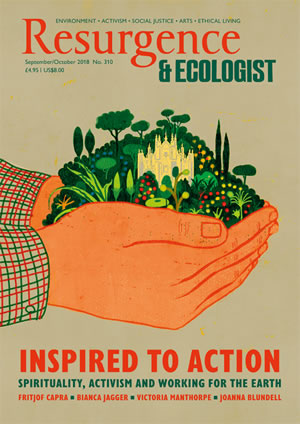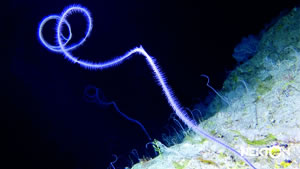It was in 2015 that oceans researcher and campaigner Alex Rogers first experienced the full visual impact of ocean plastic pollution. “I was diving in Honduras in 2015 at Utila in the Bay Islands and there were all these beautiful coral reefs, but as we came around the island we were faced with a raft of rubbish stretching out as far as you could see: plastic bottles, expanded polystyrene, fibreglass, every kind of human waste you could imagine... I have never witnessed such a huge quantity of debris. It was horrific.”
Not that it was his first brush with ocean plastic. That had come three years earlier, when he and his team were exploring seamounts in the Indian Ocean between Madagascar and Antarctica. “We were taking samples from deep-sea corals and sediments at depths of up to 1,500 metres, in one of the most remote places in the world, and we were finding all these plastic fibres. My initial reaction was, ‘Fantastic – here’s my next paper!’ But a microsecond later I was thinking, ‘But it’s terrible – if this stuff is here, it must be everywhere.’”
But while marine plastics are indeed a horrific and truly global problem, they are by no means the only human assault on the health of our oceans and their wildlife. Indeed they aren’t even the most serious. “The number one problem for the oceans has to be climate change,” says Rogers, “because of the sheer scale and scope of the disruption it threatens – to ocean chemistry, ocean circulation, ocean ecosystems, polar sea ice and ice caps, and the knock-on effects on the planet as a whole. And these changes will be completely irreversible over human timescales.”
Next comes over-fishing, and destructive fishing: entire ecosystems hoovered up by industrial fishing fleets, and seabeds trashed by trawling. One example: “In the 1960s Russian and Japanese fleets discovered huge stocks of fish over seamounts in the Pacific – the Emperor Seamounts chain – and just started hauling them in without even knowing what was there. The stocks crashed. Soon New Zealand, Australian and EU fleets began deep-sea trawling. One population after another was collapsed, with huge damage to habitats.
“They went for them with bottom trawlers gouging up the seabed and with massive impacts on target species like orange roughy, which grows very slowly, does not mature until it’s 30 or 40 years old, and lives up to 150 years with a very low level of natural mortality. A whole industry ramped up incredibly quickly with no scientific research to even show what was there, or the population dynamics. Finally the science has caught up, but not fast enough to stop the damage. And even though catches are much more sustainable now, almost all the fish are taken by bottom trawling, which is about the most destructive industrial fishing method there is.”
Pollution comes in at number three – including plastics, along with the whole gamut of toxic chemicals, heavy metals and so on that work their way into the oceans once they have served their human purpose. “We know for sure that plastics are a serious hazard, but we still don’t know how bad. We are looking at three main impacts: entanglement of animals, for example in fishing nets; ingestion, which in extreme cases can completely block cetaceans’ digestive tracts, for example; and toxicity.
“Plastics attract and concentrate persistent organic pollutants like polychlorinated biphenyls (PCBs) from seawater, and they often contain toxic additives in their own right – such as phthalates, flame retardants and polybrominated diphenyl ethers (PBDEs, which came in as replacements for PCBs) – and now they are being found in whale tissues. Lots of organisms eat microplastic particles, mistaking them for food, so the fear is that they will keep on recycling persistent organic pollutants back into the food chain long after we thought we were rid of them.”
Rogers was recently appalled to discover environmentally harmful chemicals in his supermarket shower gel – oxybenzones, best known as ultraviolet light blockers in sunscreens recently banned from commercial sale in Hawaii from 2021 because of the harm they do to coral reefs.
“At first I was really surprised to see that substance. But then I found that oxybenzones are everywhere – not just in sunscreens and shower gels, but also in shampoos, hair conditioners, make-up, mascara, and even in some foods. The concentrations may be low, but it still goes down the plughole and gets into the environment and into drinking water. And people are using multiple products. It gets into them through their skin, and the impacts of different pollutants can combine. People assume the stuff they buy is benign – if it’s on sale it must be OK. But it’s not. We all need to be aware of all these chemicals and avoid them.”
Amid this litany of oceanic gloom, there is actually some good news – at least, reason to hope that coral reefs and the marine life they support may be better than feared at surviving the warmer oceans caused by global warming. New research, some of it Rogers’, shows that coral ecosystems extend much deeper than had previously been realised, into cool waters that may serve as biodiversity refuges even as surface waters heat up. These discoveries are now causing oceanographers to rethink their division of the sea into depth zones, with a new mesophotic zone, from 40 metres deep down to 150 metres, that is far more important than previously realised.
“Most of our knowledge of coral reefs comes from scuba-diving depths down to 40 metres, which scientists call the altiphotic – shallow, sun-bathed coral depths. Then below that we have the mesophotic, where there’s still enough light for some light-harvesting corals and algae, but lower temperatures and less disturbance. What we have found is that many species inhabit both zones, but the top 40 metres is suffering the most from human activities.
“So what we need to know is this: if the altiphotic gets significantly disturbed, can it repopulate from the mesophotic? And that’s how it looks. For example, in Chagos, which has suffered intense coral bleaching, we saw only 10% coral cover in the top 10–15 metres. But out of sight at 40–60 metres, in places there was still 100% coral cover. So it’s looking like really good news. If key species can survive at these depths, that’s very encouraging. But we should still be worried – coral reefs remain highly vulnerable and threatened by climate change and ocean acidification. Another danger is that fishers are increasingly targeting this zone.”
Go down deeper still, and more surprises are lurking in the newly defined rariphotic, which extends from 150 metres down to 300 metres. Its existence as a distinct zone was first revealed in Curaçao by Carole Baldwin of the Smithsonian Institution, who realised that this zone, considered ‘deep sea’ under the old definitions, contained many species from families typically associated with shallow water. So the Nekton mission – funded by the Nekton Foundation, of which Rogers is chief scientist – decided to take a look in Bermudan waters.
“We have seen the same thing in Bermuda,” says Rogers. “For example, we found moray eels at 250 metres. The most common rariphotic fish were rough-tongued bass and saddle bass, again from families mainly found in shallow waters. But life on the rariphotic seabed is also distinctive – we have been finding entire new ecological communities at mesophotic and rariphotic depths that have remained undiscovered until now.
“Key finds include more than 40 new species of photosynthetic algae that have found a safe refuge from herbivorous fish, which range to a depth of 60 metres, and extensive coral gardens. The corals look like gigantic bedsprings in gigantic fields, along with sea fanssandagiant sponges, each with myriad other animals living on them in fractal fashion. They are known as black corals, but they are actually white. In Bermuda we found one entirely new species of black coral, and three new records – species never previously seen there. And we have found dozens of new species living on them, including a dozen or more tanaids –crustaceans that look like mini-lobsters.
“DNA analysis shows that algae of the same genus are found in Australia, with a common ancestor some 5 million years ago – roughly the same time that the Isthmus of Panama rose up and separated the Atlantic and Pacific oceans. We think these algal communities exist over a wide area of the tropics that has not yet been examined. Researchers have often focused on obvious, colourful species like corals and fish, but when you look harder you find other, less showy species that have previously been ignored but still have their tales to tell.”
In fact, Rogers adds, there are discoveries to be made pretty much wherever you look in the deep ocean. “Whenever we move into a new area, we expect to find new species. So far we have only explored 0.0001% of the pelagic zone (the waters from the surface down to 11,000 metres), and less than 0.1% of the deep seabed. Even our understanding of the broad patterns of biodiversity distribution is pretty shaky.”
New technologies are constantly opening up opportunities for discovery – like ‘torpedoes with handles’ that scuba divers can ride down to 90 metres using mixed-gas rebreathers, and Triton submersibles with acrylic spheres offering a 360° view of the ocean around. “They were developed mainly for the mega-yacht market but they’re also great for research,” says Rogers. “Ours are good to 300 metres, but some models can go to 1,000 metres. And if we go deeper I’ll expect to find even more novel ecosystems.”
But there’s no time to lose. “The ocean is changing so fast, and the negative effects of human activity create a huge urgency. We are having massive impacts on things we don’t even know are there. It’s vital that scientists, governments and UN bodies know what is there in the deep ocean before we allow it to be trashed for short-term profit. What we need here is a scale of scientific endeavour similar to space exploration. This is far too big a problem for conventional scientific approaches.”
The fourth biggest threat to the oceans? Habitat destruction, for example of coastal mangrove forests cut down for fuel or shrimp farms, sea-grass meadows and deep-water reefs ploughed up by trawlers, or uniquely biodiverse hydrothermal vents destroyed by mining for their valuable rare earth metals. While the seabed is legally defined in the UNCLOS (Law of the Sea) treaty as “the common heritage of mankind, the exploration and exploitation of which shall be carried out for the benefit of mankind as a whole”, the International Seabed Authority, laments Rogers, “has been giving out licences for exploration for deep-sea mining with very little knowledge or understanding of what life is present, never mind how it will be impacted”.
With the oceans generating an estimated US$2.5 trillion annual value to the global economy, surely a few tens of billions a year for deep ocean research and protection would be both precautionary and affordable? But sadly, as Rogers explains, that prospect is remote. “We are seeing a widespread trend to nationalism, militarism and unilateralism just as we need the reverse – to come together to deal with the really big existential problems of climate change, feeding a growing world population sustainably, and conserving global biodiversity. All the rising global tensions are a huge distraction from the real issue we are facing – how to maintain the planet in a habitable condition for 10 billion people.”







